A Modeling Approach for the Balanced Gliding Trajectory of a Hypersonic Vehicle with Pneumatic Iteration
Abstract
1. Introduction
2. Model Method
2.1. Aerodynamic Model of Hypersonic Aircraft
2.1.1. Navier–Stokes (N-S) Equation
2.1.2. Boltzmann Equation
2.2. Ballistic Modeling Model
2.2.1. Kinetic Model
2.2.2. Constraint Model
2.3. Pneumatic–Ballistic Coupling Iterative Algorithm Model
3. Simulation Verification and Analysis
3.1. Approximate Mars-16B Geometric Modeling
3.2. Pneumatic Calculations
3.2.1. Validation of Pneumatic Simulation Methods
3.2.2. Pneumatic Calculations
3.3. Ballistic Modeling
3.3.1. Ballistic Modeling
3.3.2. Stability Verification
3.3.3. Correctness Analysis
4. Discussion
5. Conclusions
- (1)
- The aerodynamic simulation results indicated that the Mars-16B aerodynamic model developed in this study displayed reasonable stability in the hypersonic regime. At α = 0°, the lift showed significant insensitivity, and CL increased in a nearly linear manner with altitude, which was consistent with the characteristics of classical aerodynamic theory. A negative pitch moment coefficient signified that the vehicle maintained static stability, preventing any loss of stability during flight.
- (2)
- The aerodynamic iterative ballistic modeling approach revealed that the missile navigated through various altitudes during flight, showcasing unique aerodynamic performance at each level. The aerodynamic iteration effectively modeled the actual flight trajectory curve and ensured precise terminal guidance. Compared to other ballistic modeling techniques, the proposed pneumatic iteration process enhanced the precision and stability of terminal guidance.
- (3)
- This work demonstrated that results obtained from imprecise aerodynamic formulas, such as those based on Newtonian flow theory, significantly differed from those derived from high-fidelity CFD data. This highlights the importance of accurate aerodynamic data in advanced design processes.
- (4)
- The approach outlined in this work advanced the development of hypersonic vehicle trajectory modeling techniques and enhanced the capabilities of existing technologies. These findings are particularly significant for simulating the balanced glide trajectory of hypersonic vehicles and for missile terminal penetration.
- (5)
- Simulation results indicated that the aerodynamic–ballistic coupling iteration process took, on average, 25% longer duration per run than the simplified model documented in the literature. However, the accuracy of the terminal guidance was markedly improved (with longitude error reduced significantly from 0.12° to 0.03°). This trade-off can potentially be optimized through offline pre-computation of aerodynamic databases. Additionally, employing smaller models or implementing deep learning for automated iteration could enhance the modeling accuracy of hypersonic aircraft, thereby facilitating their broader application in practical contexts.
Author Contributions
Funding
Data Availability Statement
Conflicts of Interest
Appendix A
| Symbols | Meaning |
|---|---|
| Knudsen number | |
| fluid density | |
| divergence operator | |
| viscous stress tensor | |
| dynamic viscosity | |
| second viscosity | |
| fluid pressure | |
| external force per unit volume | |
| total energy per unit mass | |
| heat flux vector | |
| gas constant | |
| temperature | |
| slip value | |
| non-sliding wall surface value | |
| specific heat ratio | |
| gas molecule collision relaxation parameters | |
| local equilibrium distribution functions | |
| gas molecular velocity distribution function | |
| position space | |
| molecular velocity | |
| time | |
| local Maxwell equilibrium distribution function | |
| gas molecular number density | |
| gas molecular number pressure | |
| dimensionless Prandtl number | |
| constant pressure | |
| thermal conductivity | |
| power exponent | |
| , | interaction indices |
| flow regime control parameter | |
| Parameters for speed | |
| heading angle | |
| altitude | |
| range | |
| propulsion | |
| D | drag |
| L | lift |
| angle of attack | |
| time-varying mass | |
| longitude | |
| latitude | |
| ballistic inclination | |
| ballistic deflection angle | |
| tilt angle | |
| dimensionless time | |
| dimensionless altitude | |
| dimensionless velocity | |
| Earth’s radius | |
| gravitational acceleration | |
| flight altitude | |
| reference region | |
| missile–target distance | |
| yaw line-of-sight angles | |
| pitch line-of-sight angles | |
| missile velocity | |
| ballistic inclination | |
| deflection angle | |
| yaw rate lead angle | |
| heat flux density | |
| total overload | |
| dynamic pressure | |
| constant coefficient | |
| aerodynamic database storing | |
| residual | |
| net external force | |
| aircraft’s velocity | |
| Mach number query increment |
References
- Xu, B.; Shi, Z. An overview on flight dynamics and control approaches for hypersonic vehicles. Sci. China Inf. Sci. 2015, 58, 1–19. [Google Scholar] [CrossRef]
- Kumar, G.N.; Ikram, M.; Sarkar, A.K.; Talole, S.E. Hypersonic flight vehicle trajectory optimization using pattern search algorithm. Optim. Eng. 2018, 19, 125–161. [Google Scholar] [CrossRef]
- Xiaodong, Y.; Shi, L.; Shuo, T. Analysis of optimal initial glide conditions for hypersonic vehicles. Chin. J. Aeronaut. 2014, 27, 217–225. [Google Scholar] [CrossRef]
- Ding, Y.; Yue, X.; Chen, G.; Si, J. Review of control and guidance technology on hypersonic vehicle. Chin. J. Aeronaut. 2022, 35, 1–18. [Google Scholar] [CrossRef]
- Zhao, J.; Zhou, R. Reentry trajectory optimization for hypersonic vehicle satisfying complex constraints. Chin. J. Aeronaut. 2013, 26, 1544–1553. [Google Scholar] [CrossRef]
- Zang, L.; Lin, D.; Chen, S.; Wang, H.; Ji, Y. An online guidance algorithm for high L/D hypersonic reentry vehicles. Aerosp. Sci. Technol. 2019, 89, 150–162. [Google Scholar] [CrossRef]
- Lu, P.; Forbes, S.; Baldwin, M. Gliding guidance of high L/D hypersonic vehicles. In Proceedings of the AIAA Guidance, Navigation, and Control (GNC) Conference, Boston, MA, USA, 19–22 August 2013. [Google Scholar]
- Cunyu, B.; Peng, W.; Guojian, T. Integrated method of guidance, control, and morphing for hypersonic morphing vehicle in glide phase. Chin. J. Aeronaut. 2021, 34, 535–553. [Google Scholar] [CrossRef]
- Hou, L.; Liu, H.; Yang, T.; An, S.; Wang, R. An intelligent autonomous morphing decision approach for hypersonic boost-glide vehicles based on DNNs. Aerospace 2023, 10, 1008. [Google Scholar] [CrossRef]
- Jiawei, L.; Jiangfeng, W.; Liming, Y.; Chang, S. A hybrid lattice Boltzmann flux solver for integrated hypersonic fluid-thermal-structural analysis. Chin. J. Aeronaut. 2020, 33, 2295–2312. [Google Scholar]
- Shuhua, Z.; Zhenyu, Y.; Wenwen, Z.; Weifang, C. Numerical simulation of hypersonic thermochemical nonequilibrium flows using nonlinear coupled constitutive relations. Chin. J. Aeronaut. 2023, 36, 63–79. [Google Scholar]
- Cao, L.; Liu, L.; Ji, P.; Guo, C. Adaptive Fast Smooth Second-Order Sliding Mode Fault-Tolerant Control for Hypersonic Vehicles. Aerospace 2024, 11, 951. [Google Scholar] [CrossRef]
- De Oliveira, H.B.; Khompysh, K.; Shakir, A.G. Strong solutions for the Navier–Stokes–Voigt equations with non-negative density. J. Math. Phys. 2025, 66, 041506. [Google Scholar] [CrossRef]
- Haçat, G.; Çibik, A.; Yilmaz, F.; Merdan, S.K. Optimal Control problems of NS-α and NS-ω turbulence models: Analysis and numerical tests. Numer. Algorithms 2025. [Google Scholar] [CrossRef]
- Wang, Y. Global well-posedness and large-time behavior for anisotropic inhomogeneous Navier-Stokes equations with mixed partial dissipation. Electron. Res. Arch. 2025, 33, 4284–4306. [Google Scholar] [CrossRef]
- Tripathi, V.K.; Maurya, R.K.; Mahajan, A. Nonlinear stability analysis of thermal convection in a fluid layer with slip flow and general temperature boundary condition. Chaos Solitons Fractals 2024, 187, 115426. [Google Scholar] [CrossRef]
- Evans, B.; Walton, S. Aerodynamic optimisation of a hypersonic reentry vehicle based on solution of the Boltzmann–BGK equation and evolutionary optimisation. Appl. Math. Model. 2017, 52, 215–240. [Google Scholar] [CrossRef]
- Li, Z.; Wu, J.; Jiang, X.; Ma, Q. A massively parallel algorithm for hypersonic covering various flow regimes to solve the Boltzmann model equation. Acta Aeronaut. Astronaut. Sin. 2015, 36, 201–212. [Google Scholar]
- Nee, A.; Chamkha, A.J. Interaction of Radiation and Turbulent Natural Convection: A Pseudo-Direct Numerical Study. Adv. Appl. Math. Mech. 2022, 14, 1567–1586. [Google Scholar] [CrossRef]
- Kumar, G.N.; Penchalaiah, D.; Sarkar, A.; Talole, S. Hypersonic boost glide vehicle trajectory optimization using genetic algorithm. IFAC-PapersOnLine 2018, 51, 118–123. [Google Scholar] [CrossRef]
- Sun, W.; Ma, P.; Wang, S.; Chao, T. Analytical Solutions for Hypersonic Glide Trajectory Based on Altitude–Velocity Profile. IEEE Trans. Aerosp. Electron. Syst. 2024, 60, 7423–7436. [Google Scholar] [CrossRef]
- Zhai, S.; Yang, J. Piecewise analytic optimized ascent trajectory design and robust adaptive finite-time tracking control for hypersonic boost-glide vehicle. J. Frankl. Inst. 2020, 357, 5485–5501. [Google Scholar] [CrossRef]
- Hu, J.; Chen, W. Steady glide trajectory planning method for hypersonic reentry vehicle. J. Beihang Univ. 2015, 41, 1464–1475. [Google Scholar]
- Yi, F.; Wei, T.; Yewei, G. Optimization of configuration and trajectory for hypersonic vehicles. Acta Aerodyn. Sin. 2014, 32, 800–805. [Google Scholar]
- Wang, K.; Yan, X.; Hong, B.; Nan, W.; Wang, P. A prediction and correction reentry guidance method based on BP network and deep Q-learning network. J. Northwestern Polytech. Univ. 2025, 43, 201–211. [Google Scholar] [CrossRef]
- Rizvi, S.I.; Linshu, H.; Dajun, X.; Shah, S. Trajectory optimisation for a rocket-assisted hypersonic boost-glide vehicle. Aeronaut. J. 2017, 121, 469–487. [Google Scholar] [CrossRef]
- Yu, W.; Chen, W.; Yang, L.; Liu, X.; Zhou, H. Optimal terminal guidance for exoatmospheric interception. Chin. J. Aeronaut. 2016, 29, 1052–1064. [Google Scholar] [CrossRef]
- Xie, Y.; Pan, L.; Gu, X.; Chen, J. Gliding trajectory optimization with multiple objectives and complicated constraints for hypersonic vehicles. J. Natl. Univ. Def. Technol. 2017, 39, 9–17. [Google Scholar]
- Candon, M.; Hale, E.; Balajewicz, M.; Delgado-Gutiérrez, A.; Muscarello, V.; Marzocca, P. Parameterization of nonlinear aeroelastic reduced order models via direct interpolation of Taylor partial derivatives. Nonlinear Dyn. 2024, 112, 17649–17670. [Google Scholar] [CrossRef]
- Damljanović, D.; Vuković, Đ.; Ocokoljić, G.; Ilić, B.; Rašuo, B. Wind Tunnel Testing of ONERA-M, AGARD-B and HB-2 Standard Models at Off-Design Conditions. Aerospace 2021, 8, 275. [Google Scholar] [CrossRef]
- Huang, W.; Ma, L.; Wang, Z.-G.; Pourkashanian, M.; Ingham, D.B.; Luo, S.-B.; Lei, J. A parametric study on the aerodynamic characteristics of a hypersonic waverider vehicle. Acta Astronaut. 2011, 69, 135–140. [Google Scholar] [CrossRef]
- Wei, H.; Cai, G.; Fan, Y.; Xu, H.; Wang, J.; Zhou, Z. Online Guidance for Hypersonic Vehicle Reentry Glide Phase. J. Beihang Univ. 2023, 51, 183–192. [Google Scholar]
- Frolov, V. Optimization of Lift-Curve Slope for Wing-Fuselage Combination. In Aerodynamics; IntechOpen: London, UK, 2019. [Google Scholar]
- Cheng, Y.; Tang, S.; Lyu, S.; Wu, M.; Qiao, H. Aerodynamic statistics-based trajectory estimation of hypersonic maneuvering target. IEEE Access 2020, 8, 227642–227656. [Google Scholar] [CrossRef]
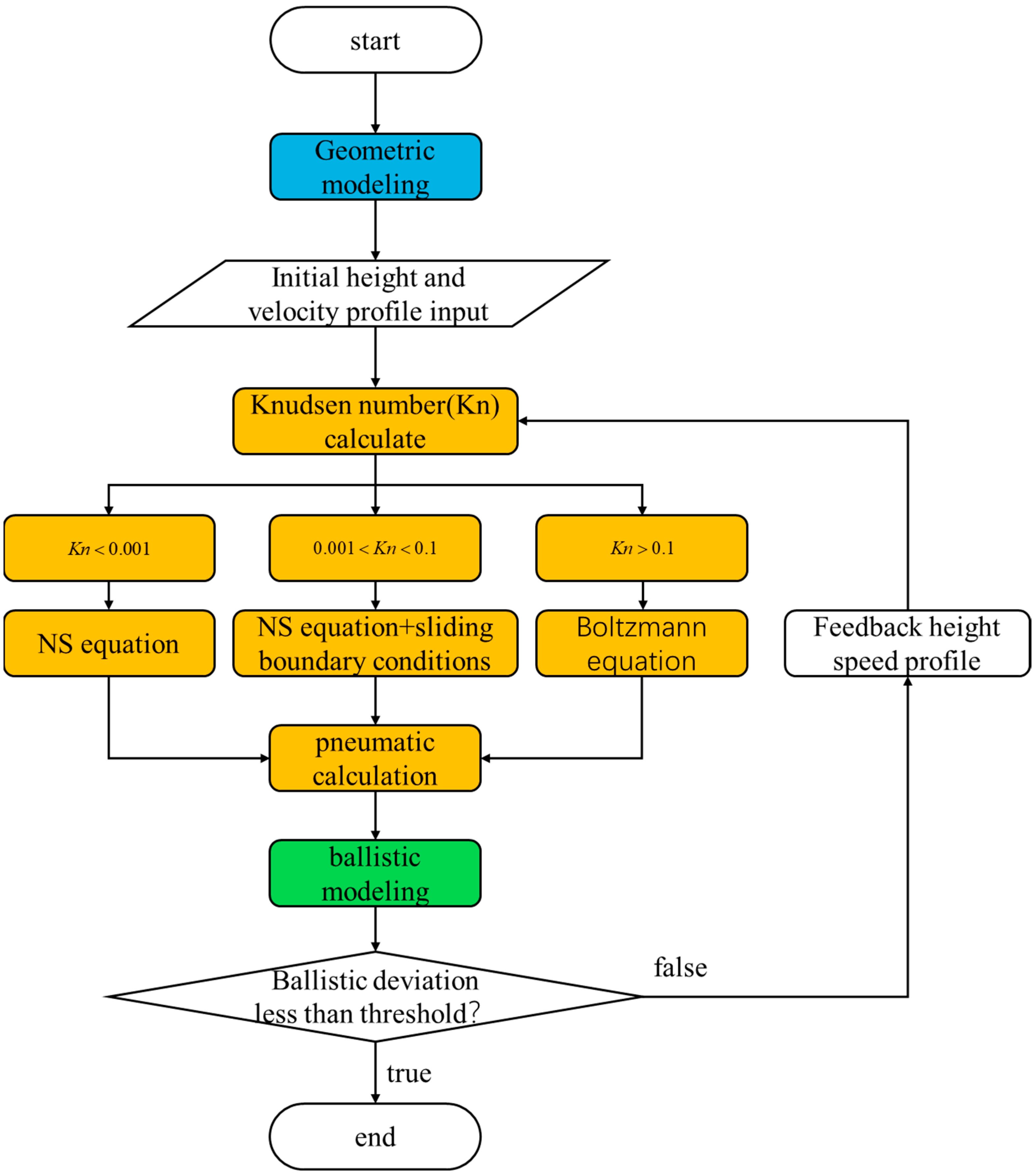
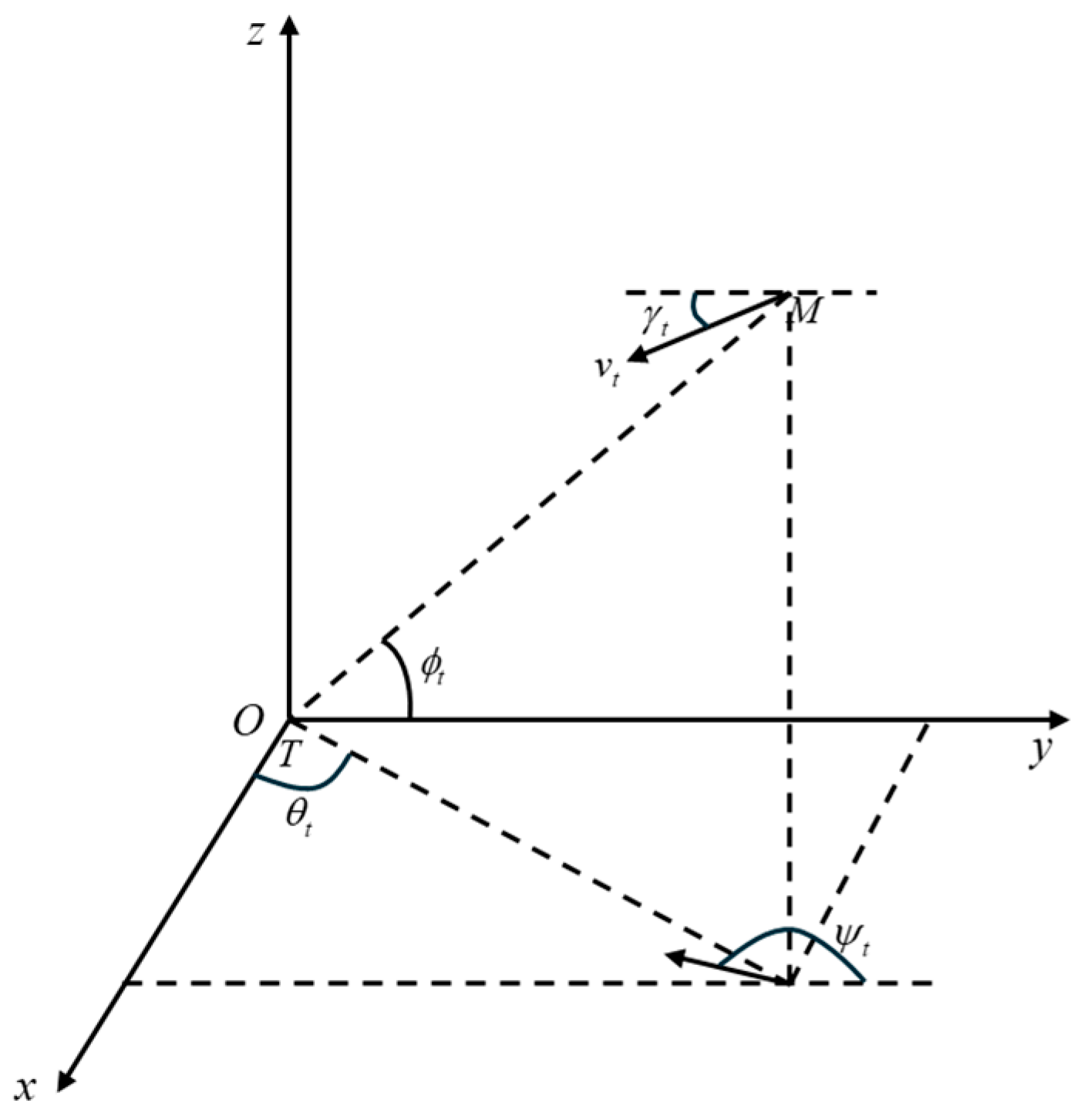
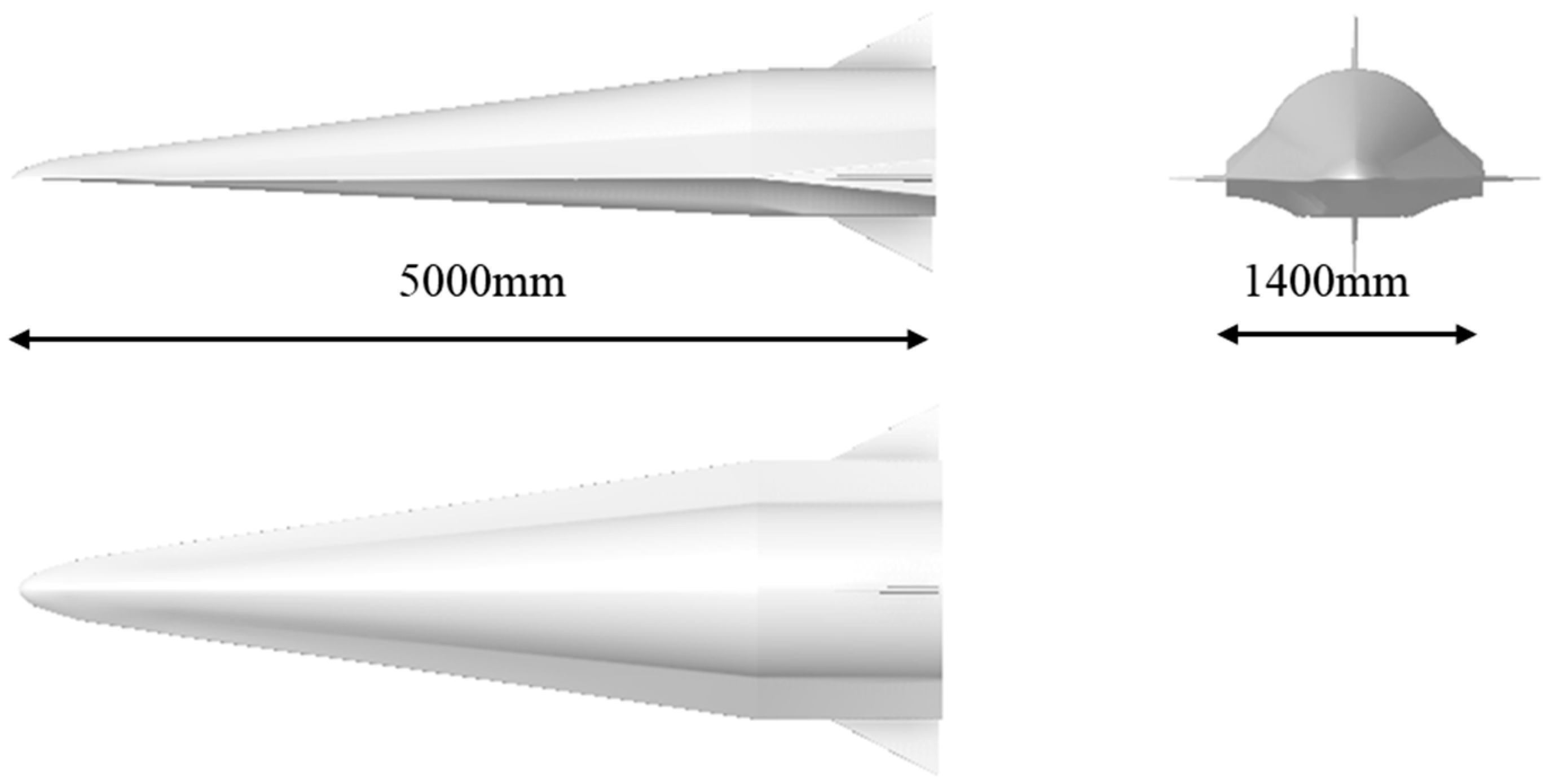
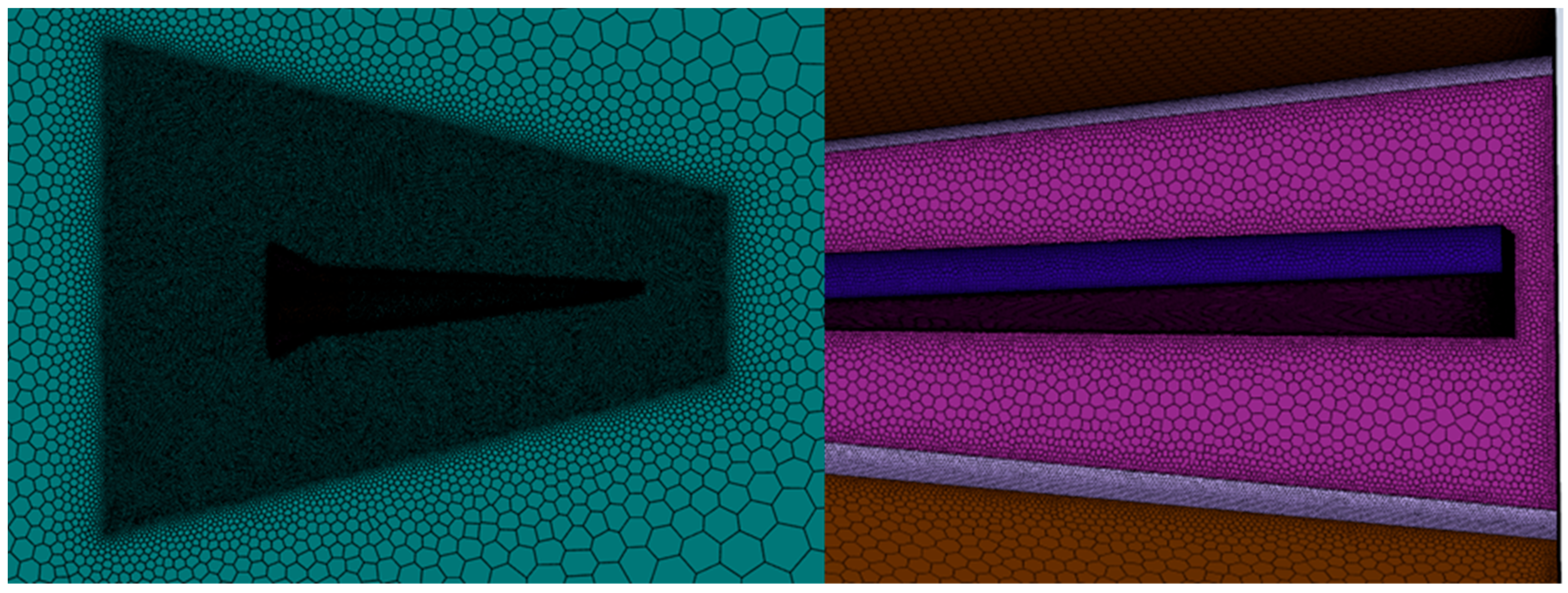
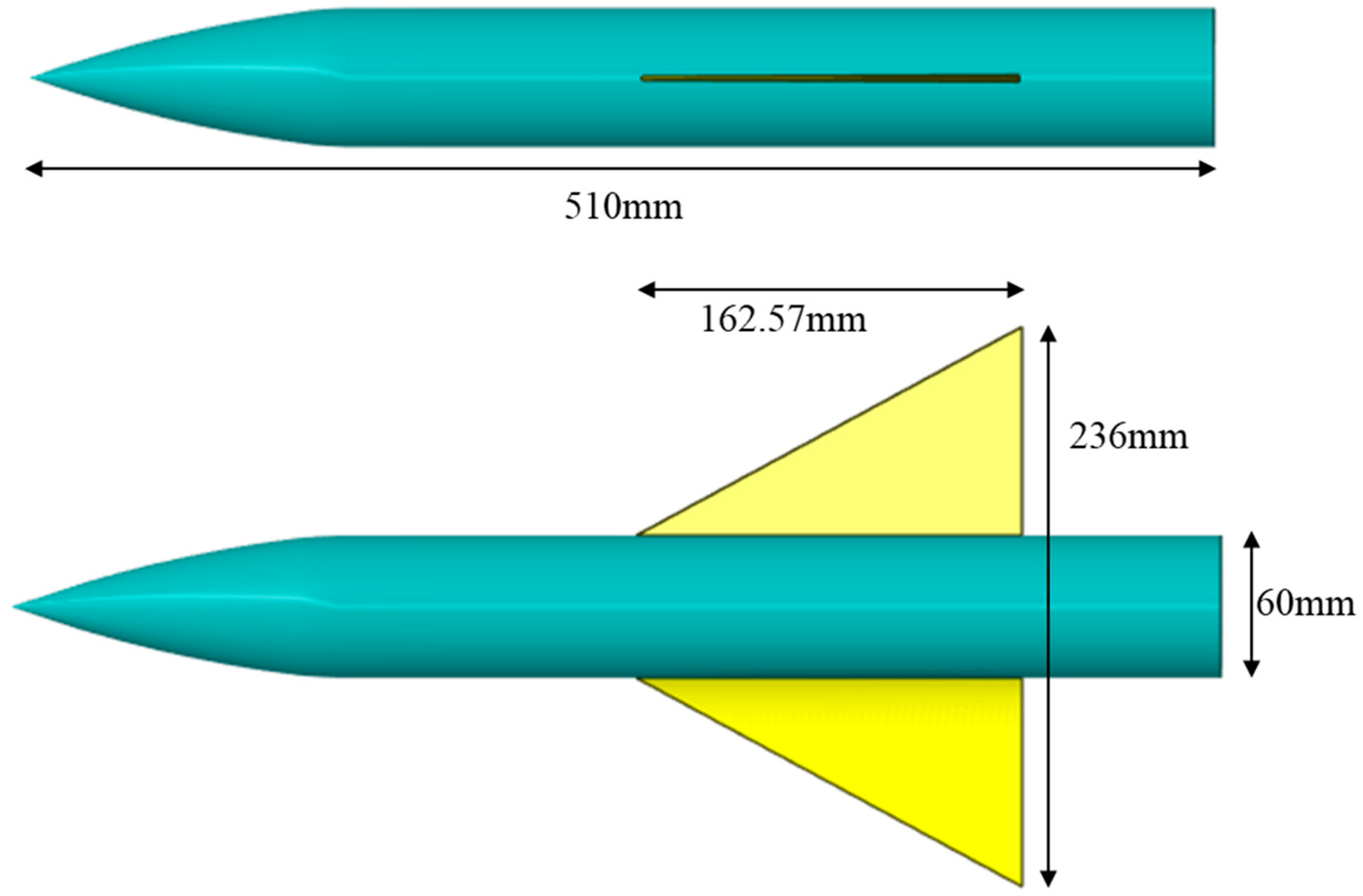
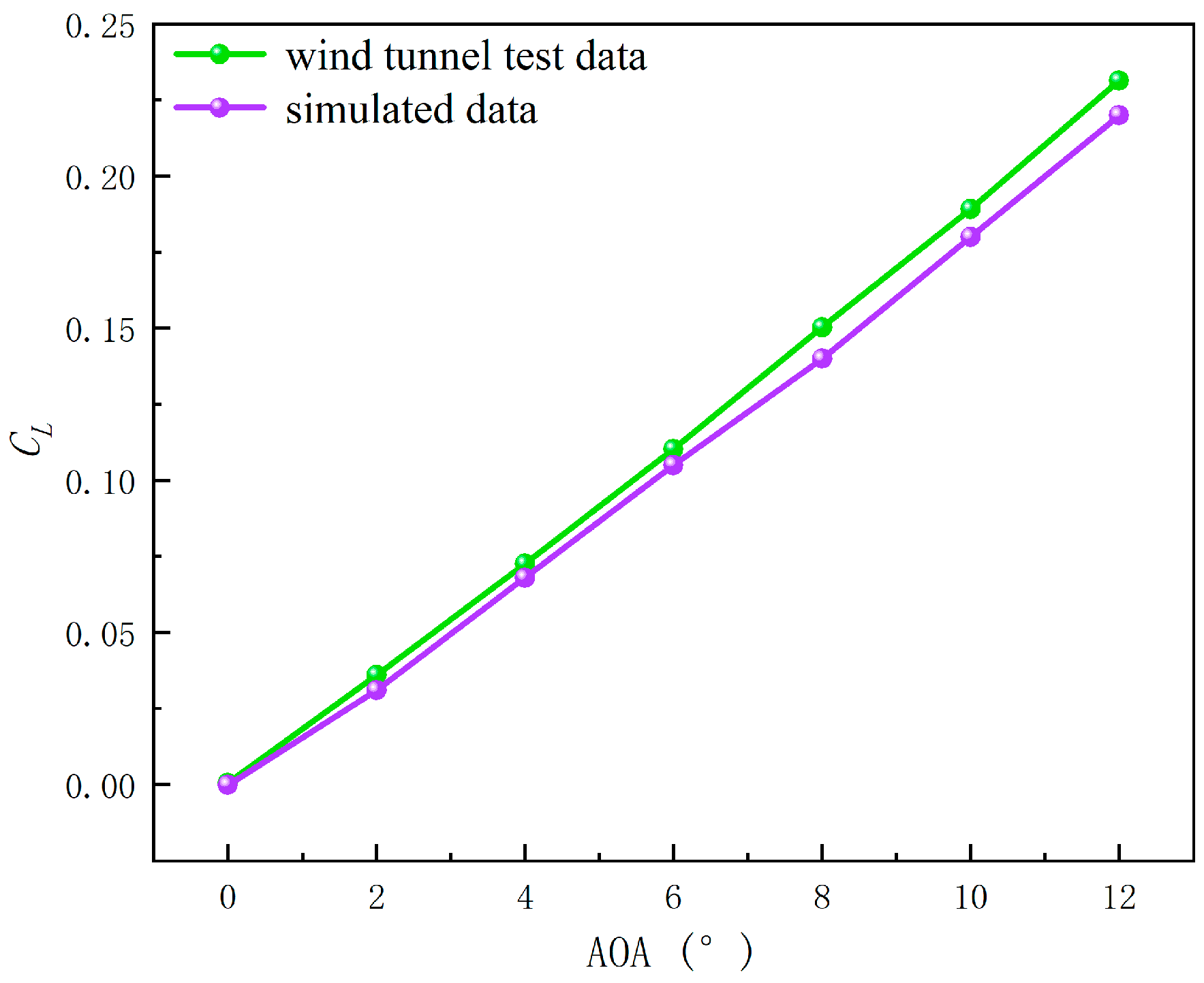
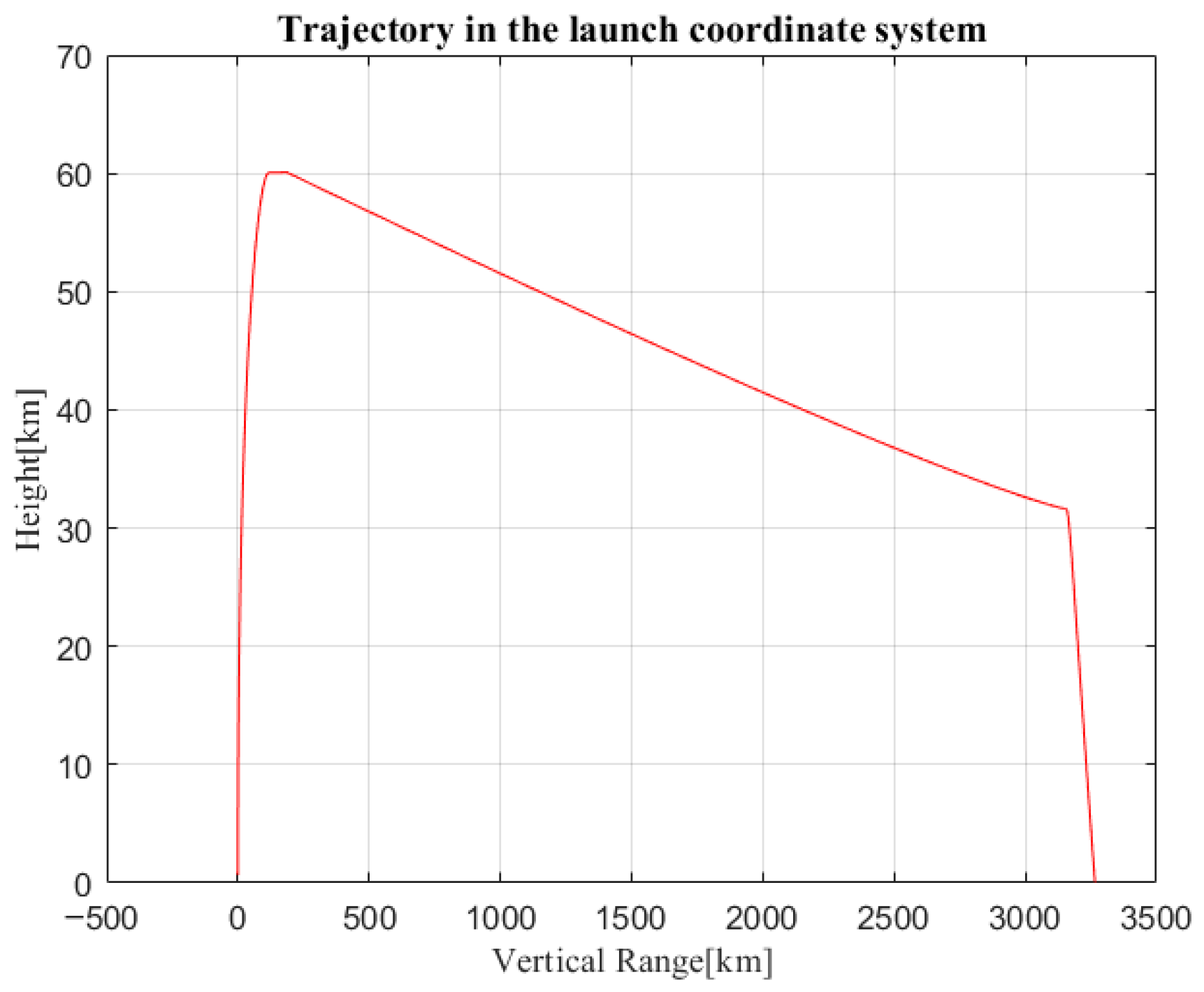
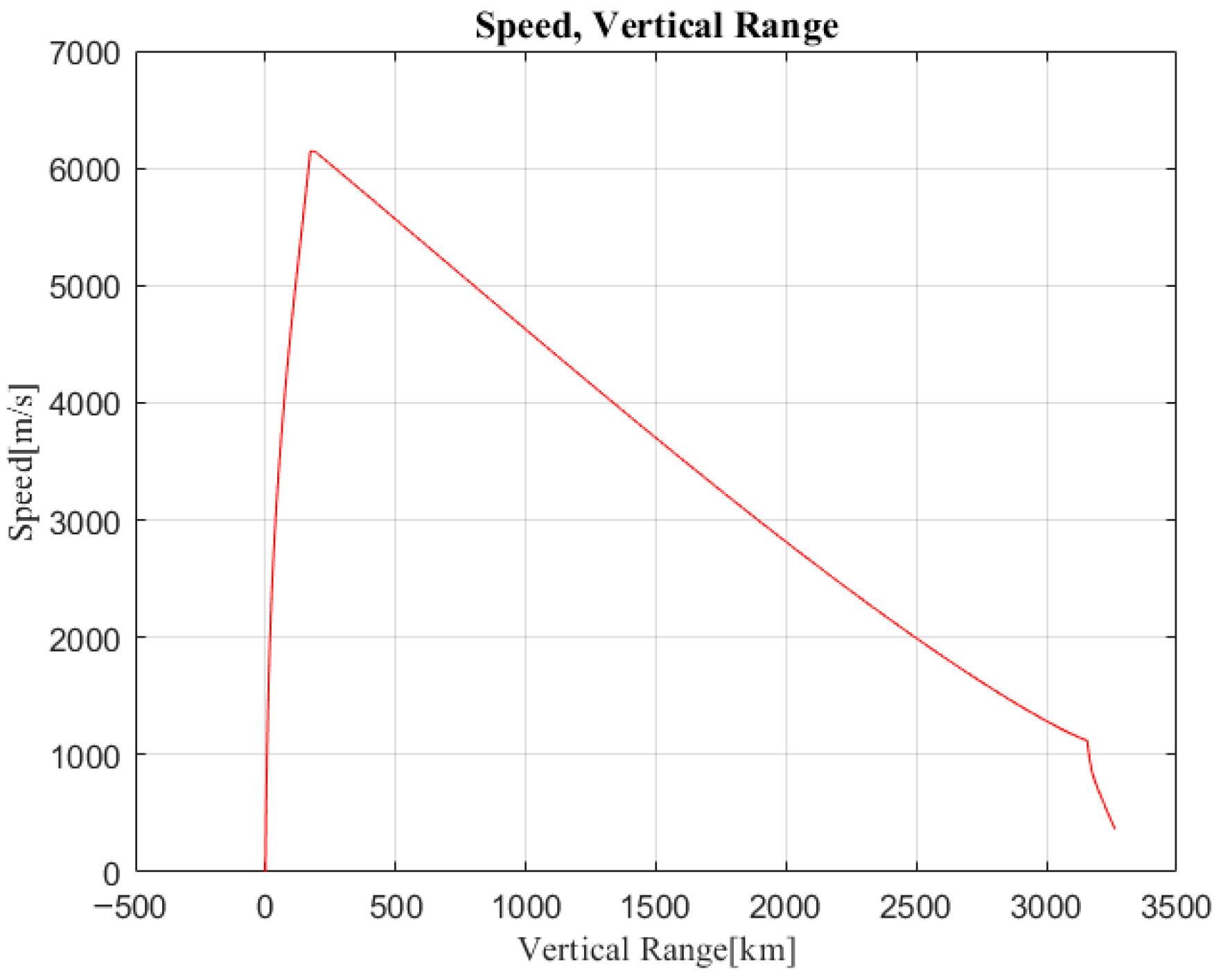
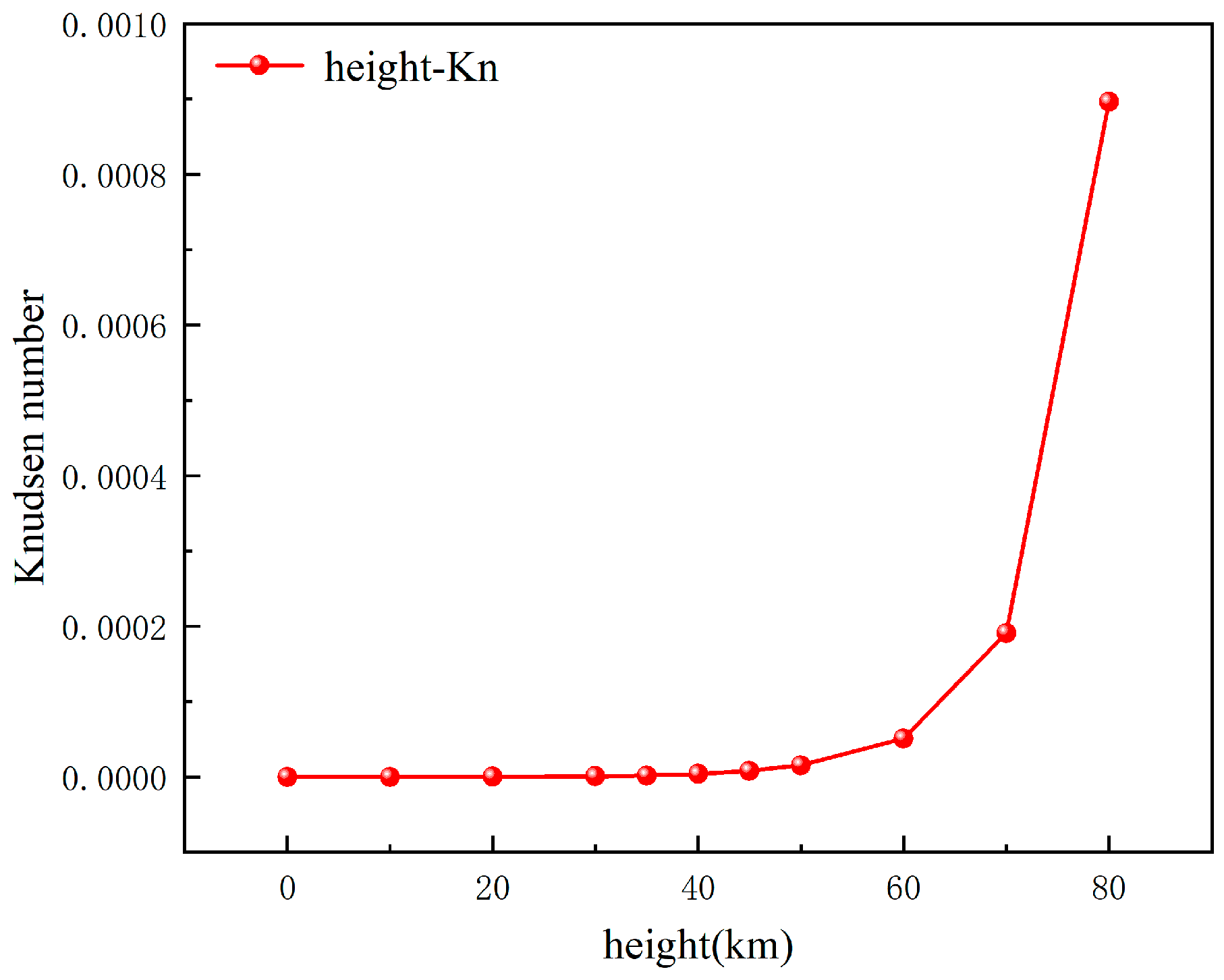
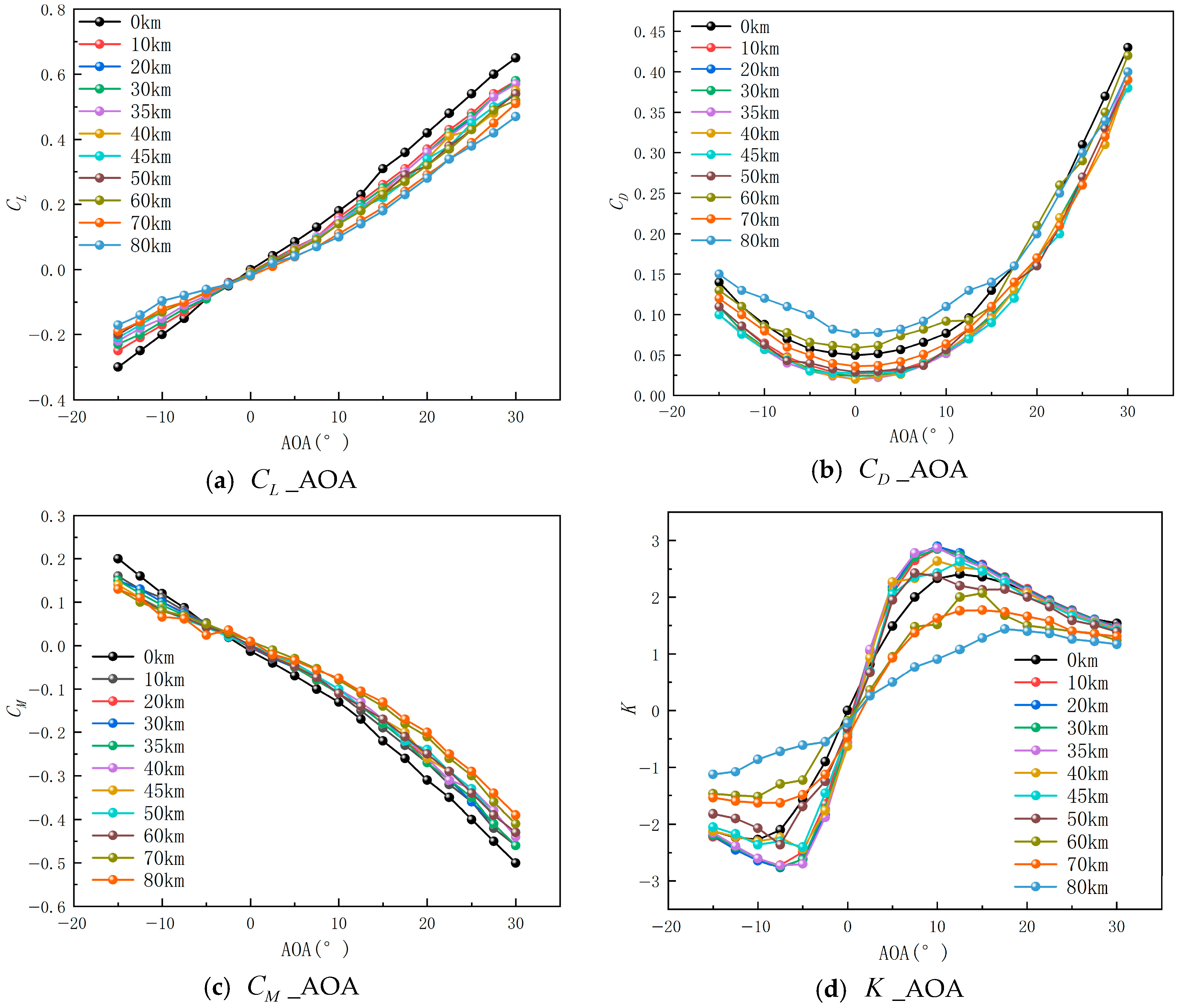
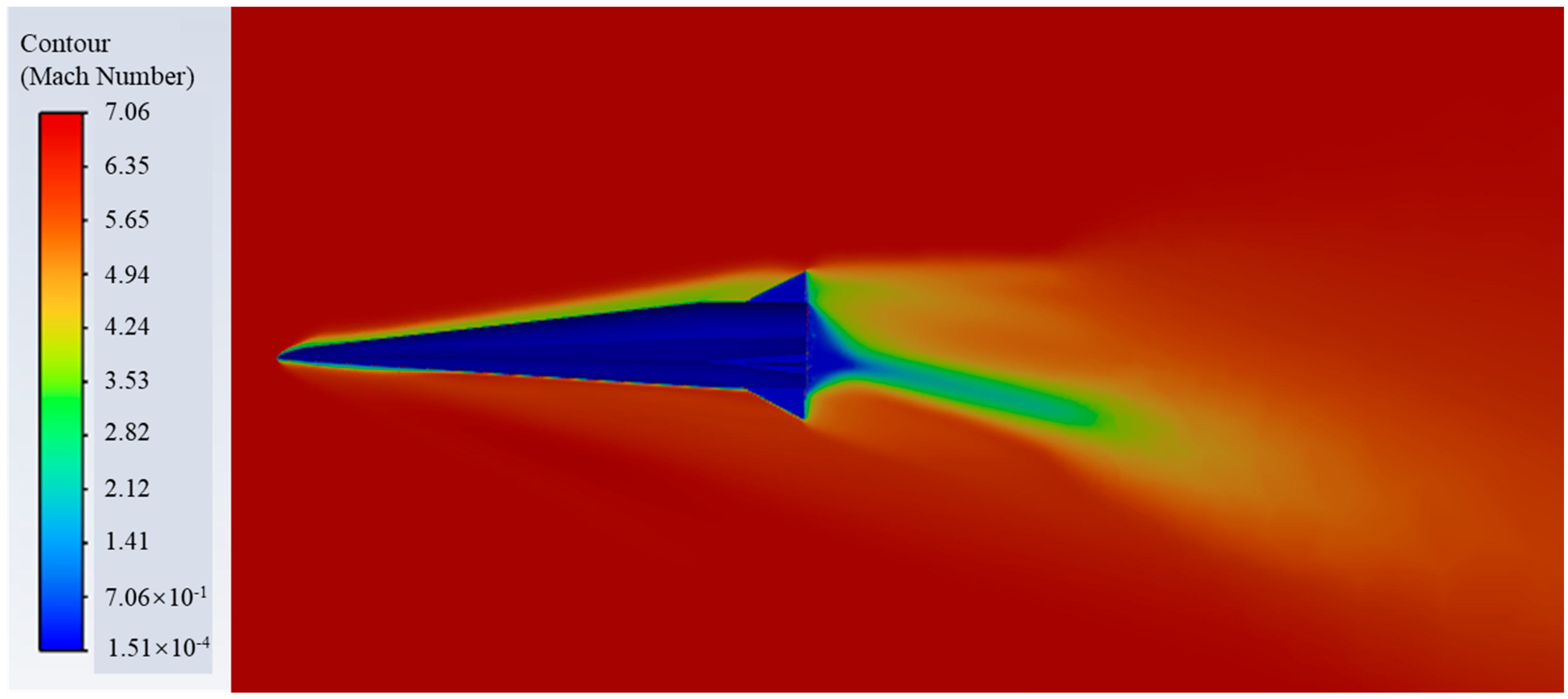
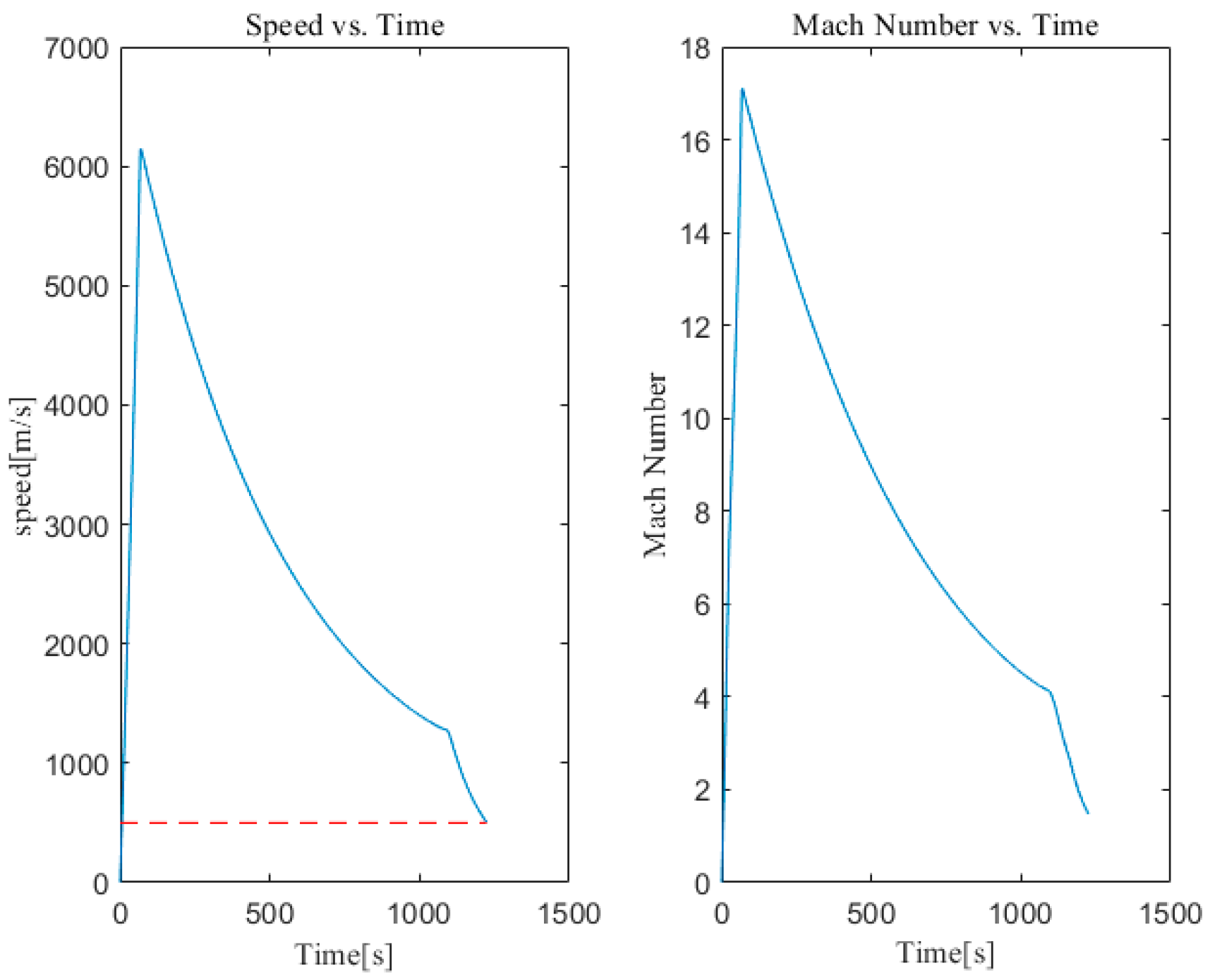
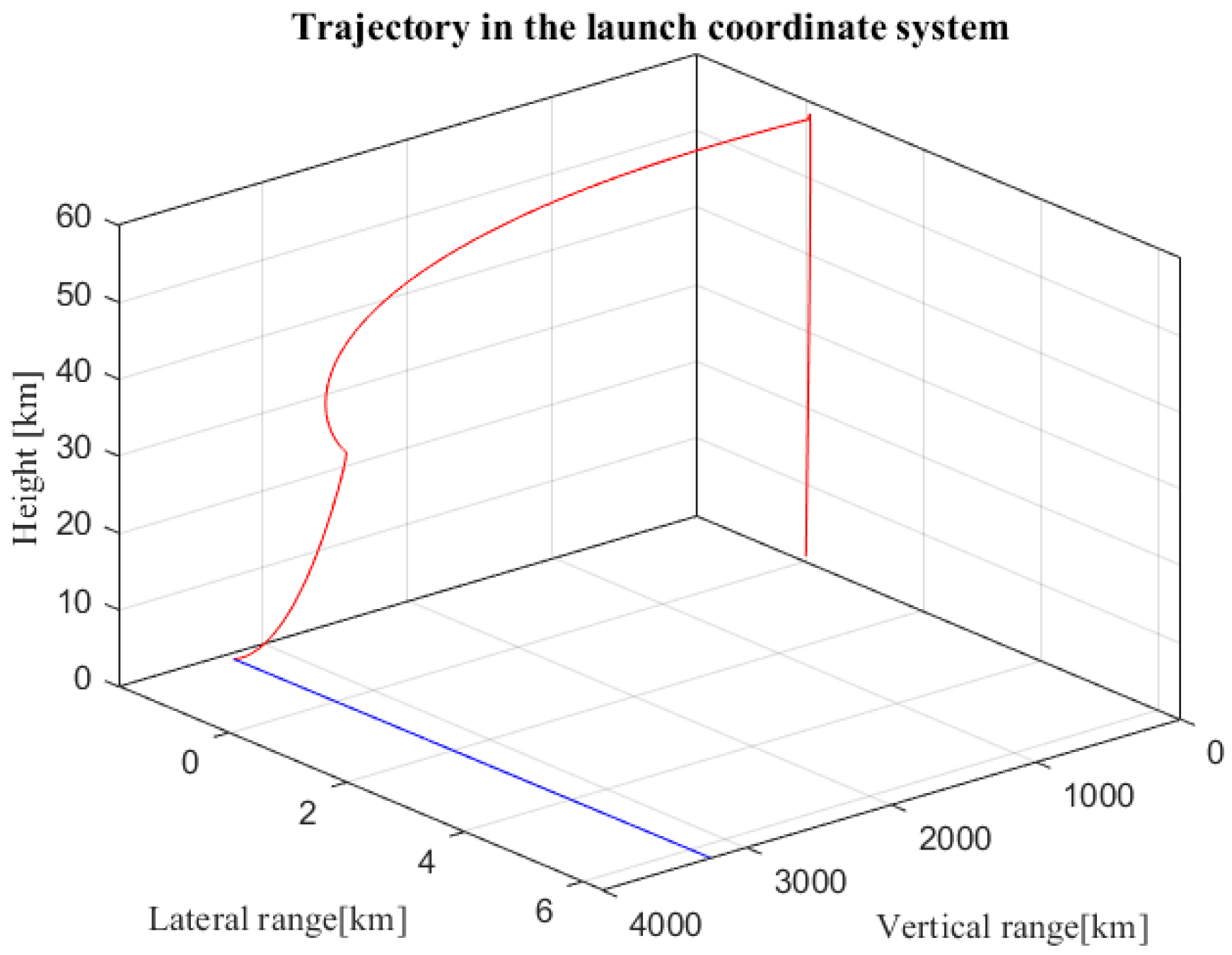
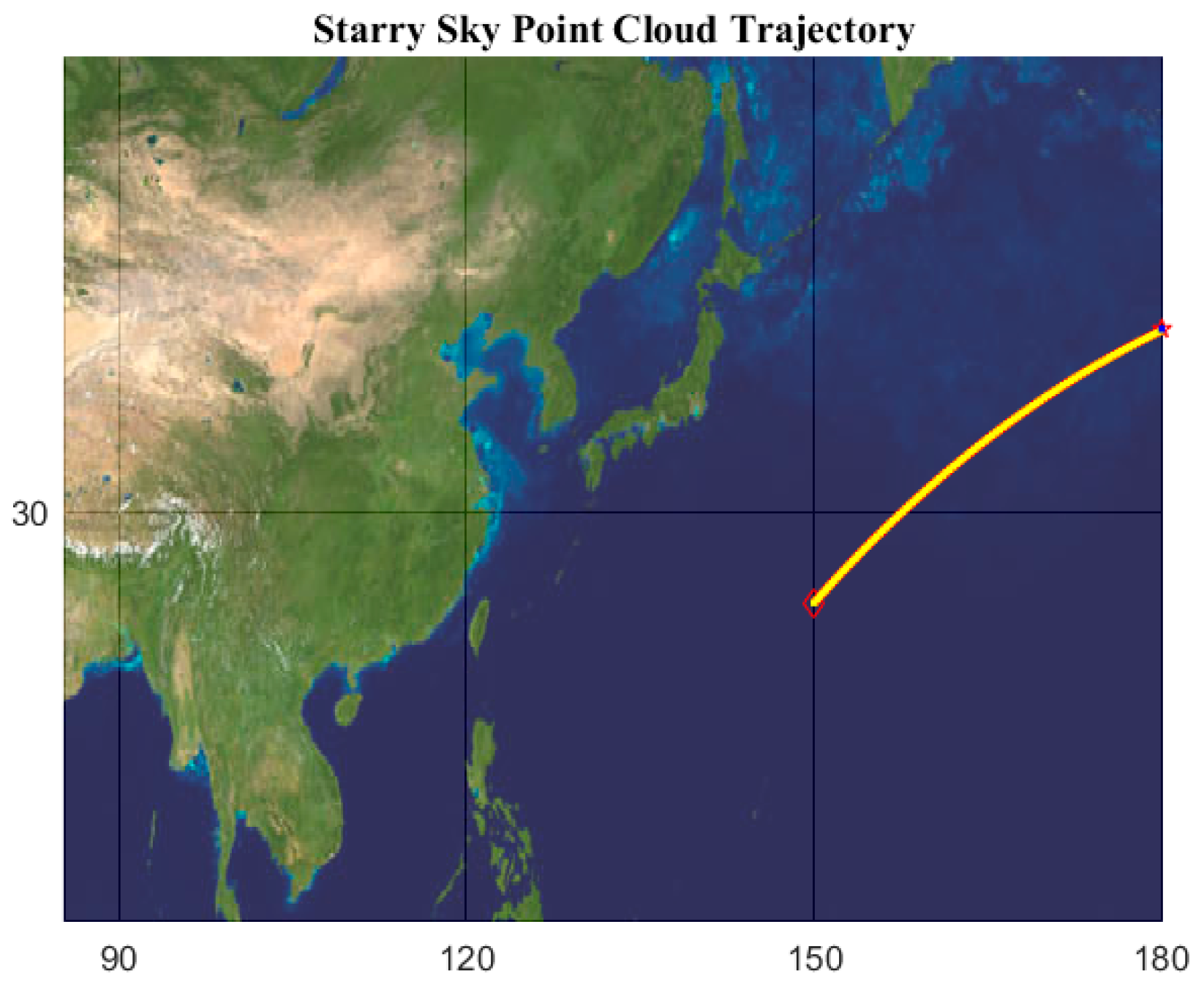
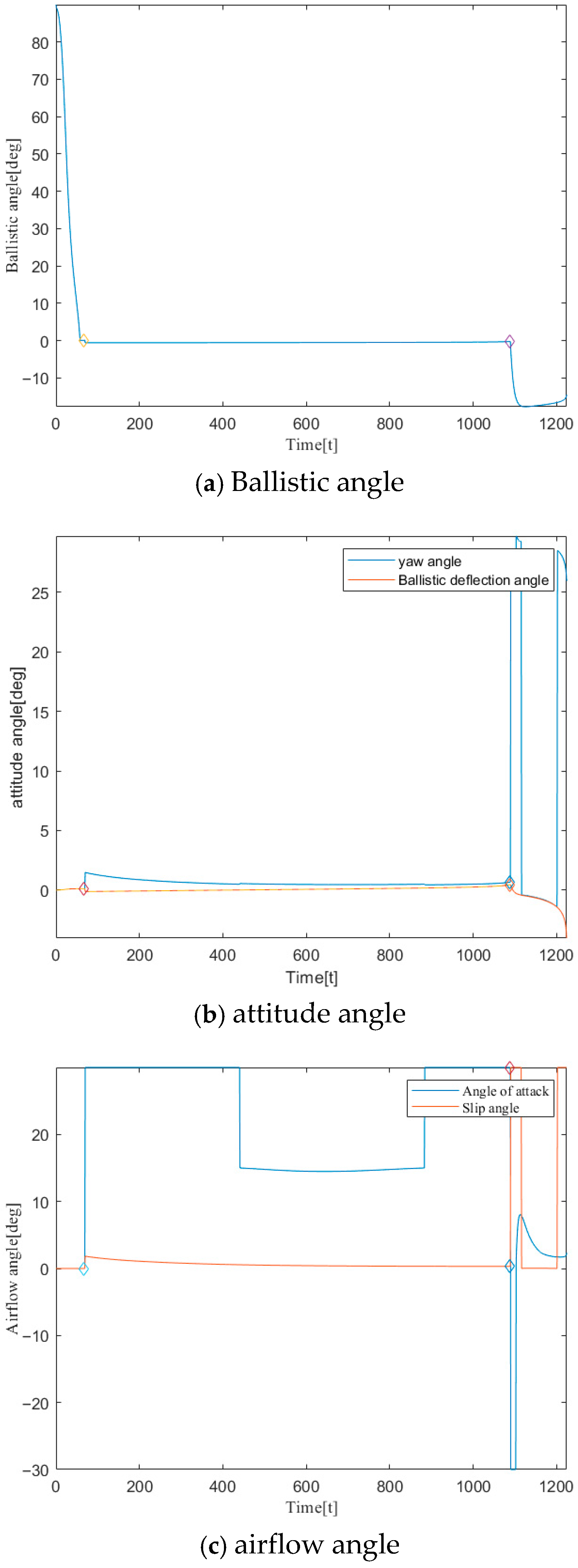
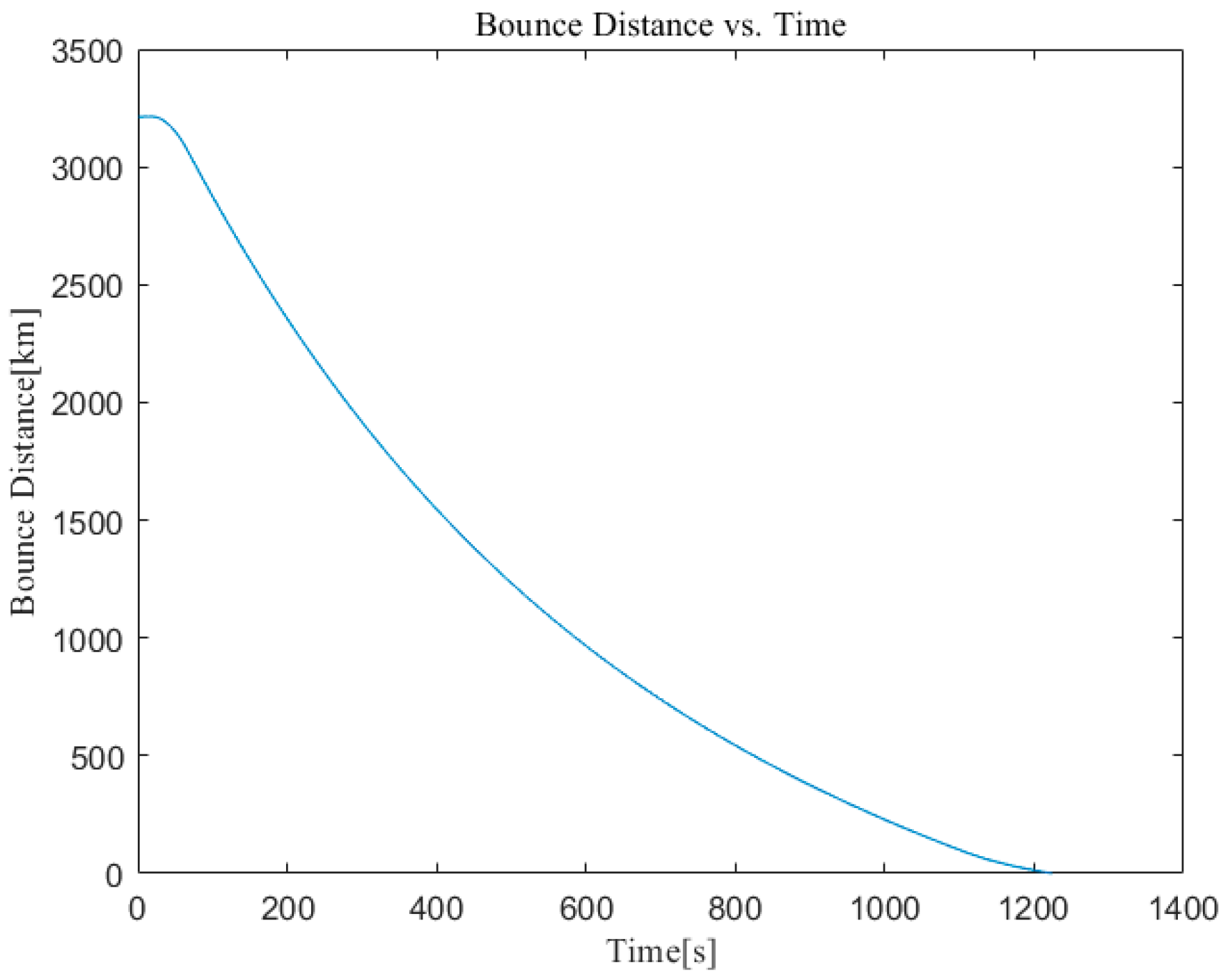
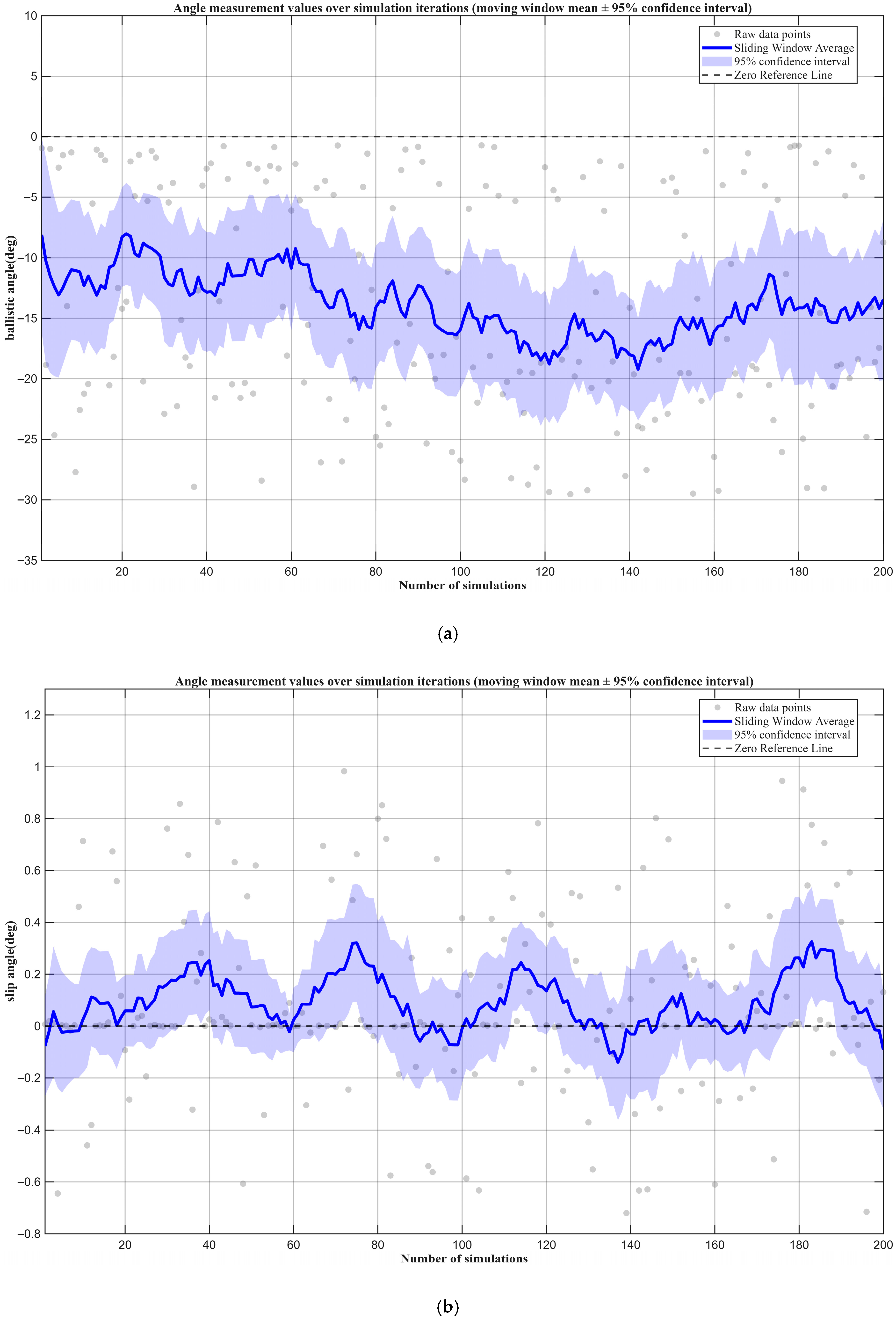
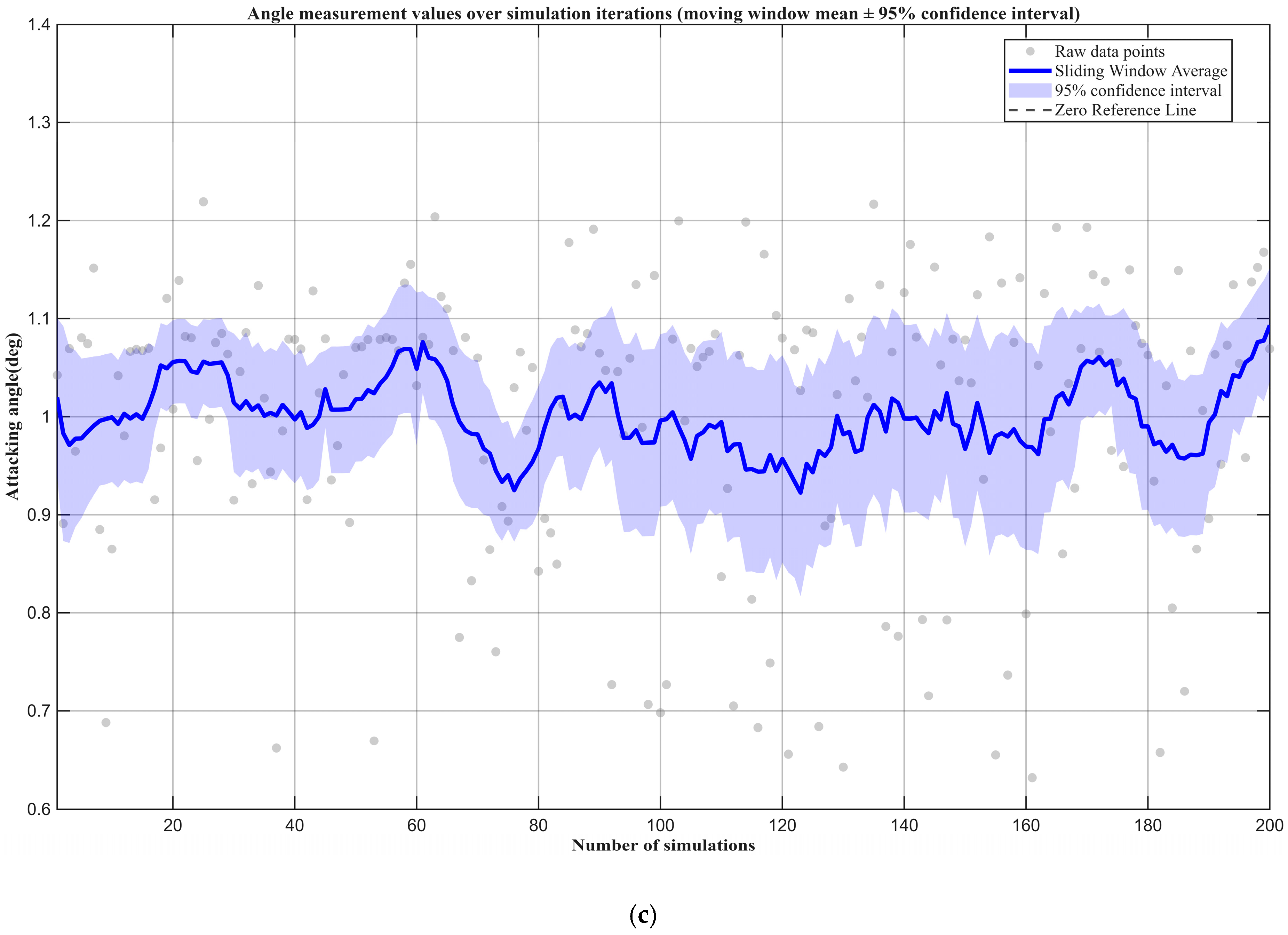
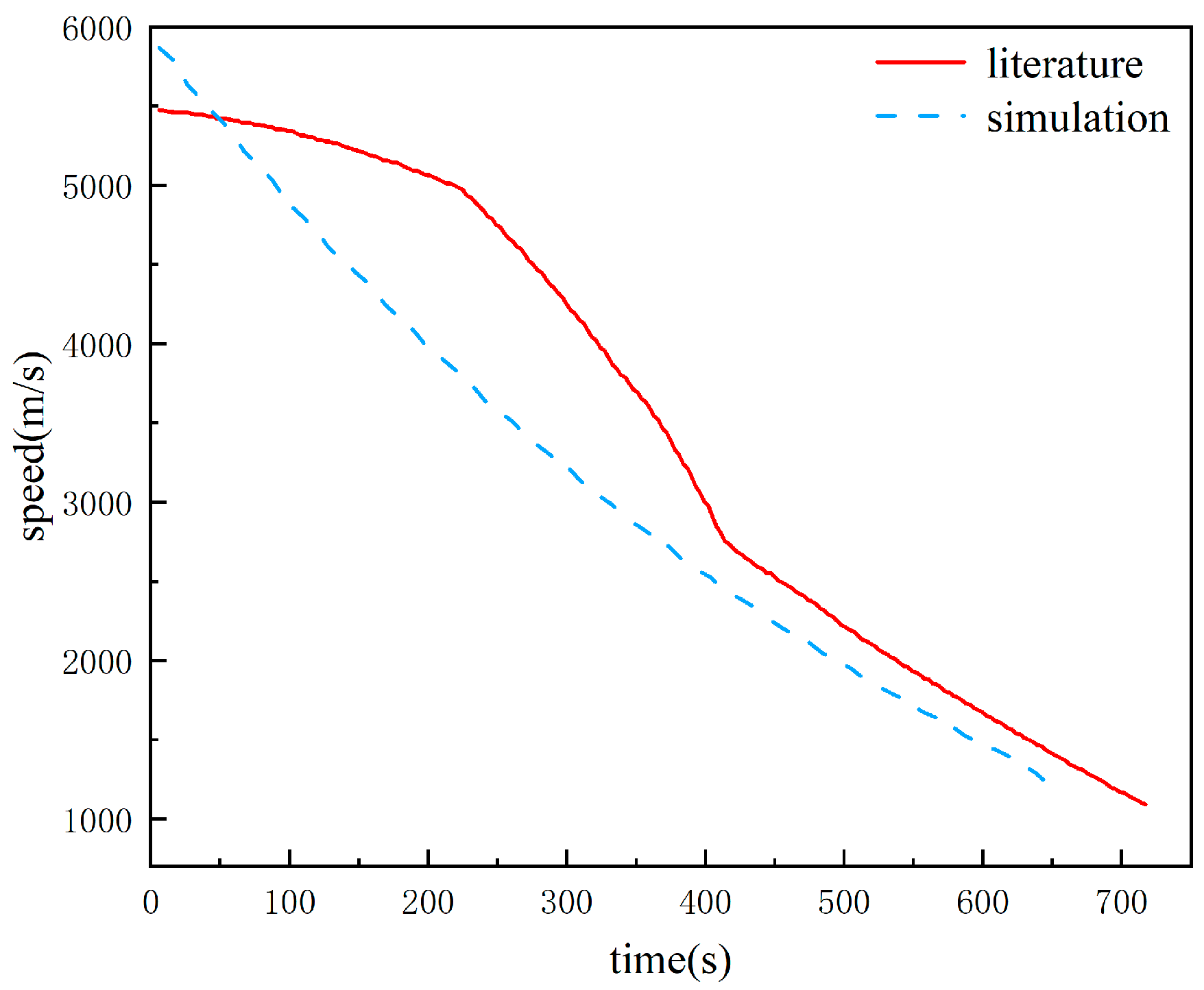
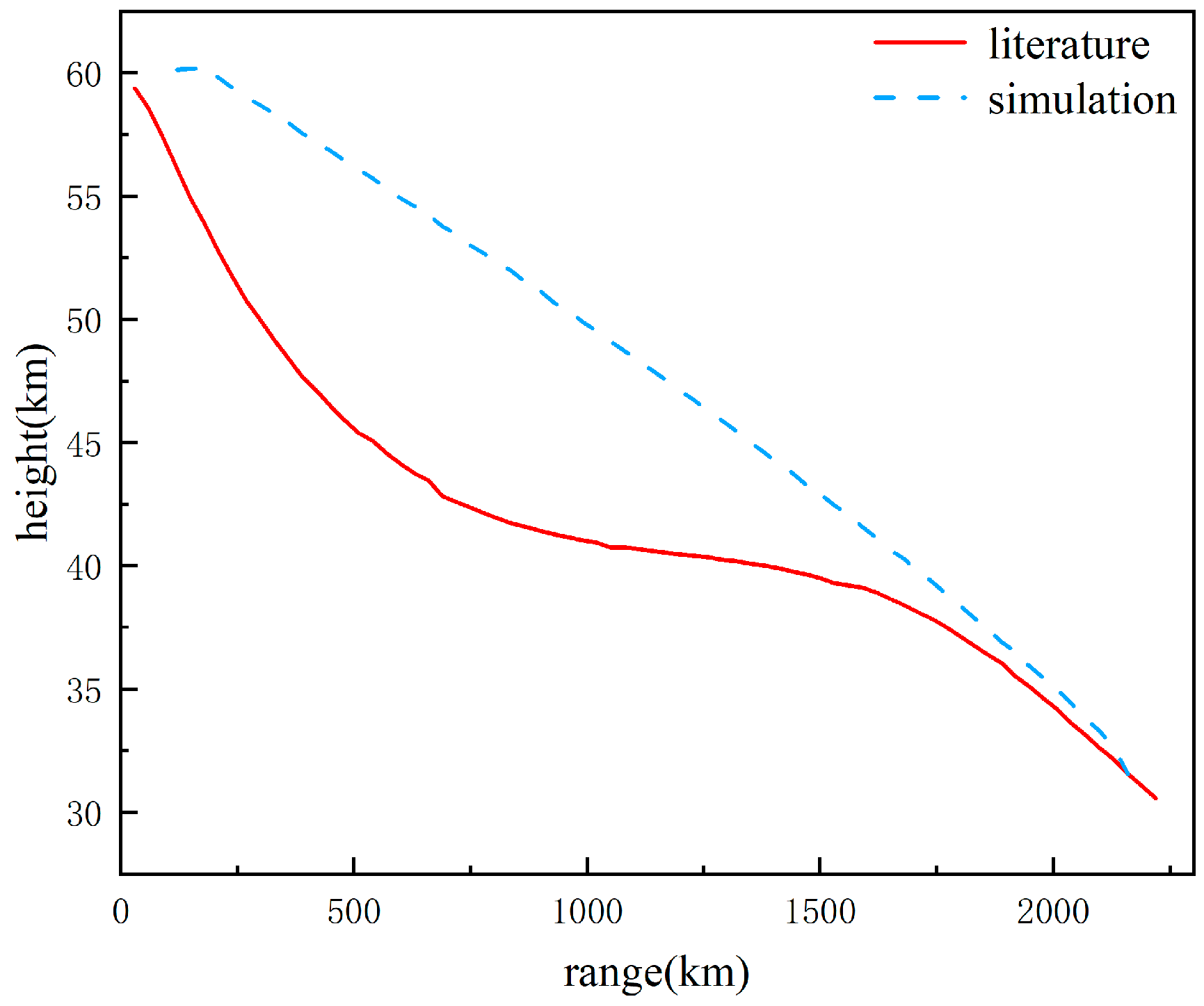

| Physical Quantity | Symbol | Unit | Numerical Value | Note |
|---|---|---|---|---|
| Weight | m | [kg] | 1400 | |
| Volume | V | [m3] | 1.63 | Including rudder |
| Density | [kg/m3] | 858.9 | ||
| Soaked area | Swet | [m2] | 13.07 | Including rudder |
| Reference area | Splan | [m2] | 13.07 | Without rudder |
| Reference length | L | [m] | 5 | |
| Reference width | B | [m] | 1.4 | Without rudder |
| Floor area ratio | r | [-] | 0.37 | |
| Center of gravity | xg | [m] | 2.64 |
| Height (km) | Speed (m/s) | Mach Number |
|---|---|---|
| 0 | 1000 | 2.9 |
| 10 | 1400 | 4.7 |
| 20 | 1600 | 5.4 |
| 30 | 1700 | 5.6 |
| 35 | 2100 | 6.8 |
| 40 | 2700 | 8.5 |
| 45 | 3000 | 9.2 |
| 50 | 3300 | 10.0 |
| 60 | 3500 | 11.1 |
| 70 | 3500 | 11.8 |
| 80 | 3500 | 12.4 |
| Symbol | Numerical Value |
|---|---|
| Launch longitude (°) | 150° |
| Launch latitude (°) | 25° |
| Launch elevation (m) | 667 |
| Target initial longitude (°) | 180° |
| Target initial latitude (°) | 40° |
| Maximum height (km) | 59 |
| Minimum glide altitude (km) | 24 |
| Active range (km) | 168 |
| Maximum range of terminal guidance (km) | 82 |
| Target speed (m/s) | 17 |
| Target heading angle (°) | 91 |
| Parameters | Method of This Paper | Traditional Approach |
|---|---|---|
| Terminal longitude error | ||
| Terminal latitude error | ||
| Maximum height deviation | ±1.2 km | ±3.5 km |
| Simulation time | 4.5 h | 5.6 h |
Disclaimer/Publisher’s Note: The statements, opinions and data contained in all publications are solely those of the individual author(s) and contributor(s) and not of MDPI and/or the editor(s). MDPI and/or the editor(s) disclaim responsibility for any injury to people or property resulting from any ideas, methods, instructions or products referred to in the content. |
© 2025 by the authors. Licensee MDPI, Basel, Switzerland. This article is an open access article distributed under the terms and conditions of the Creative Commons Attribution (CC BY) license (https://creativecommons.org/licenses/by/4.0/).
Share and Cite
Feng, G.; Bai, Y.; Liu, Y.; Wang, Y.; Wang, P. A Modeling Approach for the Balanced Gliding Trajectory of a Hypersonic Vehicle with Pneumatic Iteration. Aerospace 2025, 12, 956. https://doi.org/10.3390/aerospace12110956
Feng G, Bai Y, Liu Y, Wang Y, Wang P. A Modeling Approach for the Balanced Gliding Trajectory of a Hypersonic Vehicle with Pneumatic Iteration. Aerospace. 2025; 12(11):956. https://doi.org/10.3390/aerospace12110956
Chicago/Turabian StyleFeng, Guoxu, Yang Bai, Yu Liu, Yizhe Wang, and Peng Wang. 2025. "A Modeling Approach for the Balanced Gliding Trajectory of a Hypersonic Vehicle with Pneumatic Iteration" Aerospace 12, no. 11: 956. https://doi.org/10.3390/aerospace12110956
APA StyleFeng, G., Bai, Y., Liu, Y., Wang, Y., & Wang, P. (2025). A Modeling Approach for the Balanced Gliding Trajectory of a Hypersonic Vehicle with Pneumatic Iteration. Aerospace, 12(11), 956. https://doi.org/10.3390/aerospace12110956






